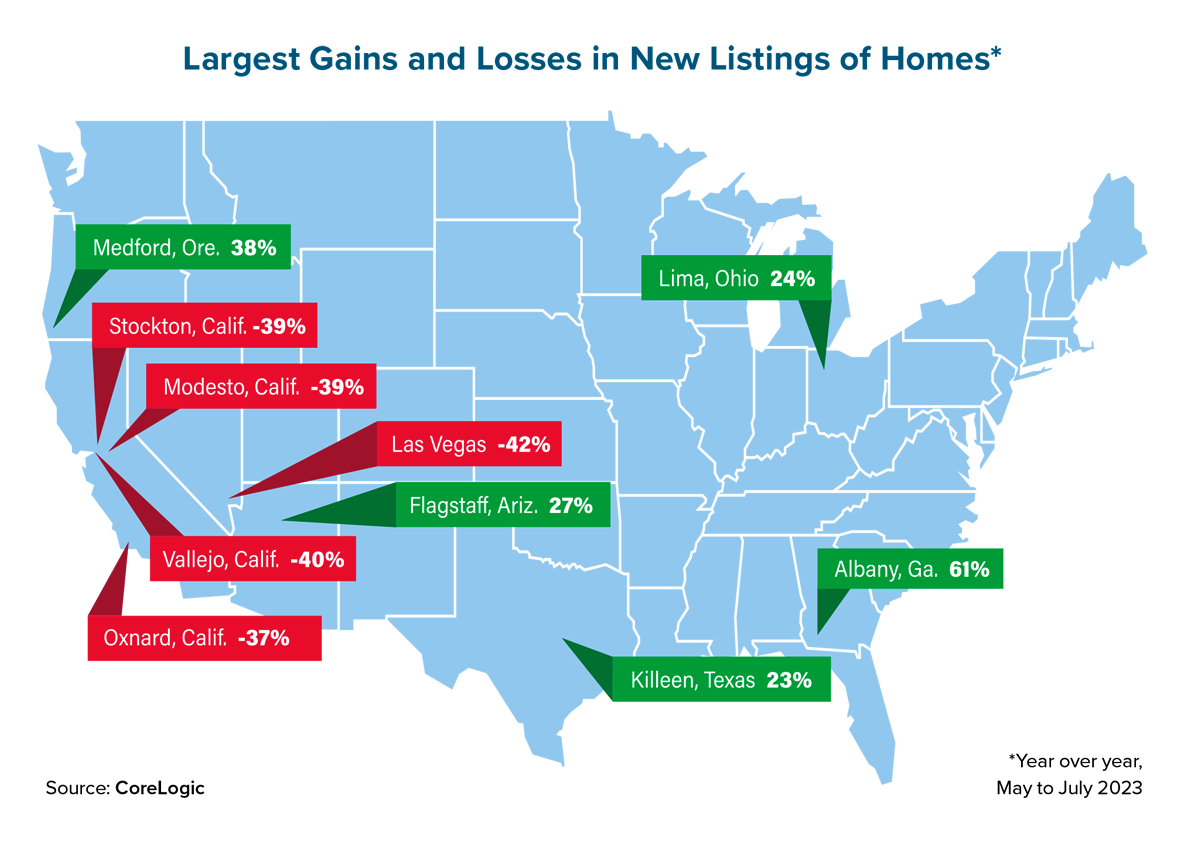Higher mortgage rates and a lack of homes available for sale continue to drag down the housing market. But while mortgage rates are expected to decline over the next year, the dearth of existing home inventory has been an ongoing constraint that has plagued housing markets for much of the past decade. As of this past summer, active inventory was some 50% lower than it was during the same time in 2019 — equating to the lowest levels in CoreLogic’s data series.
Compared to the pre-Great Recession period when existing single-family homes for sale reached 4 million, current inventory is trending at 25% of that level, or roughly 1 million homes for sale. In addition, with mortgage rates remaining elevated, there’s no reason to believe that existing inventory shortages won’t persist, particularly in markets where construction of new homes has been limited.
Nevertheless, as with many housing trends these days, there is a lot of variation across U.S. metro areas in the rates at which new listings are hitting the market. According to a CoreLogic and Multiple Listing Service database, while there were about 28% fewer listings from May through July 2023 compared to the same period in 2022, some markets had more notable declines in new listings.
The largest slowdowns in new listings are evident in Western markets, particularly in the states of California, Arizona, Nevada and Washington. For example, when looking at the metros with the largest annualized declines, eight of the top 10 are in California, where the yearly declines in new listings exceeded 30%. This is worrisome for the region as new construction activity has lagged for many years. For instance, there were about 15,000 new homes sold in all of California during the first seven months of this year, or the same number of new homes that were sold in Houston alone during the same period.
As a result of fewer homes available for sale in these Western states, CoreLogic’s home price index forecast calls for price appreciation to be relatively higher in these markets. In July 2024, the estimated year-over-year price gain is expected to be about 6% in most Western states, including Colorado, Idaho, Utah, Nevada, Oregon, California and Washington.
On the other hand, there were 18 metro areas that recorded annualized increases in new listings from May through July. The markets with the largest increases (as shown on the accompanying chart) included Flagstaff, Arizona, and Killeen, Texas. Multiple smaller markets in Michigan and Georgia also saw for-sale inventory expand during this time frame.
The proximity of Flagstaff and Killeen to larger, warm-weather tourist destinations could explain some of the growth, as could associated declines in demand for second homes, vacation homes and Airbnb rentals in these locales. But other markets that had high Airbnb activity during the COVID-19 pandemic did not see the same inventory increases. And while Michigan is not a top destination for buyers of second homes, it was a popular Midwest location during the pandemic as it offered access to lakes and other outdoors amenities. It’s not clear, however, that the pandemic alone explains the surge in new listings across some of Michigan’s metro areas.
Importantly, supply conditions play a major role in an area’s affordability metrics. As a result, regions where new construction is likely to remain subdued will face continued home price pressures, a lack of affordability and potential population losses. Conversely, regions where new construction is meeting demand for both existing households and in-migrating residents are expected to see less pressure on home prices and better affordability. For example, due to the significant share of new construction that’s occurring in Texas, CoreLogic’s yearly home price appreciation rate for July 2024 in the Lone Star State is expected to be 1.4%, or less than one-quarter of that in Western states. ●
Author
-

Selma Hepp is a senior vice president and chief economist for Cotality, formerly CoreLogic, the nation’s largest provider of advanced property and ownership information, analytics and data-enabled services. Hepp leads the economics team, which is responsible for analyzing, interpreting and forecasting trends in real estate, mortgage and insurance. Prior to joining Cotality, she was chief economist and vice president of business intelligence for Pacific Union International, later acquired by Compass.
View all posts






